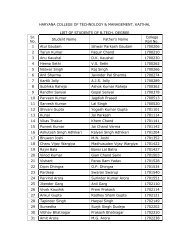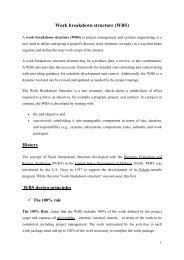You also want an ePaper? Increase the reach of your titles
YUMPU automatically turns print PDFs into web optimized ePapers that Google loves.
LECTURE NOTES OF ADVANCED DATA STRUCTURE (MT-CSE 110)<br />
The concept of sparsity is useful in combinatorics and application areas such as<br />
network theory, of a low density of significant data or connections.<br />
Huge sparse matrices often appear in science or engineering when solving<br />
partial differential equations.<br />
When storing and manipulating sparse matrices on a computer, it is beneficial<br />
and often necessary to use specialized algorithms and data structures that take<br />
advantage of the sparse structure of the matrix. Operations <strong>using</strong> standard<br />
matrix structures and algorithms are slow and consume large amounts of<br />
memory when applied to large sparse matrices. Sparse data is by nature easily<br />
compressed, and this compression almost always results in significantly less<br />
memory usage. Indeed, some very large sparse matrices are impossible to<br />
manipulate with the standard algorithms.<br />
One example of such a sparse matrix format is the Yale Sparse Matrix Format. It<br />
stores an initial sparse m×n matrix, M, in row form <strong>using</strong> three one‐dimensional<br />
arrays. Let NNZ denote the number of nonzero entries of M. The first array is A,<br />
which is of length NNZ, and holds all nonzero entries of M in left‐to‐right top‐to‐<br />
bottom (row‐major) order. The second array is IA, which is of length m + 1 (i.e.,<br />
one entry per row, plus one). IA(i) contains the index in A of the first nonzero<br />
element of row i. Row i of the original matrix extends from A(IA(i)) to A(IA(i+1)‐<br />
1), i.e. from the start of one row to the last index before the start of the next.<br />
The third array, JA, contains the column index of each element of A, so it also is<br />
of length NNZ.<br />
For example, the matrix<br />
[ 1 2 0 0 ]<br />
[ 0 3 9 0 ]<br />
[ 0 1 4 0 ]<br />
is a three‐by‐four matrix with six nonzero elements, so<br />
A = [ 1 2 3 9 1 4 ] // List of non‐zero matrix element in order<br />
IA = [ 1 3 5 7 ] // IA(i) = Index of the first nonzero element of row i in A<br />
JA = [ 1 2 2 3 2 3 ] // JA(i) = Column position of the non zero element A(i)<br />
Prepared By :<br />
Er. Harvinder Singh<br />
Assist Prof., CSE, H.C.T.M (Kaithal) Page ‐ 125 ‐







